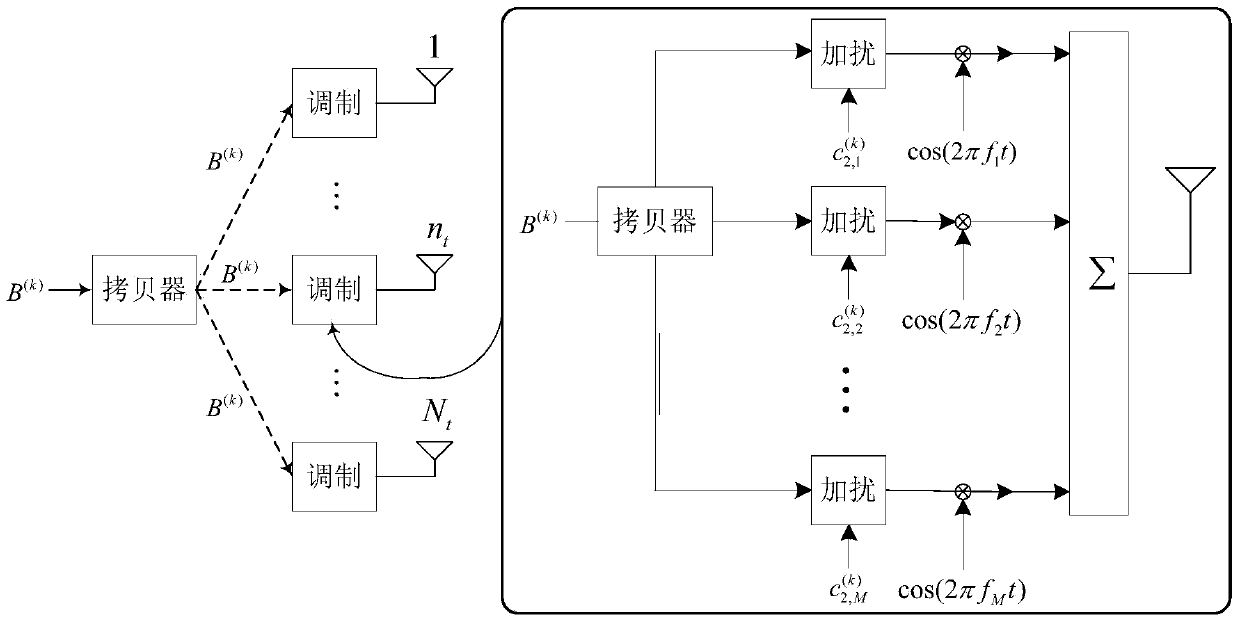Multi-input Multi-output communication system
A communication system, multi-output technology, applied in the direction of transmission system, diversity/multi-antenna system, transmission control/equalization, etc., can solve the problem of large bandwidth resource consumption, achieve transmission rate improvement, eliminate multipath interference, and bit errors The effect of rate reduction
- Summary
- Abstract
- Description
- Claims
- Application Information
AI Technical Summary
Problems solved by technology
Method used
Image
Examples
specific Embodiment approach 1
[0015] Specific implementation mode one: the MIMO communication system described in this implementation mode, in this system, complementary stirring code division multiple access coding is used to eliminate interference, and the complementary stirring code is:
[0016]
[0017] Among them, k is the number of users at the transmitting end, N t is the number of transmitting antennas, N is the code length, N≤N t , M is the number of carriers, and both M and N are positive integers.
[0018] Complementary stirring code division multiple access technology uses the stirring technology, which can reduce the bandwidth utilization rate by 1 / N under the condition that the same carrier and code length are both N. Table 1 is a comparison table of the bandwidth efficiency of the traditional complementary code division multiple access system and the bandwidth efficiency of the stirring code division multiple access system.
[0019] Table 1
[0020]
specific Embodiment approach 2
[0021] Embodiment 2: This embodiment is a further description of the MIMO communication system described in Embodiment 1. In this embodiment, the complementary mixing code is obtained through the following steps:
[0022] Step 1: Establish orthogonal matrices A and D
[0023]
[0024] Then perform step two;
[0025] Step 2: Multiply the orthogonal matrix A by the orthogonal matrix D to obtain the complementary stirred code division multiple access coding matrix C (k)
[0026] C ( k ) = C n t , 1 , t ( k ) ...
specific Embodiment approach 3
[0037] Specific implementation mode three: refer to figure 2 Describe this embodiment in detail. This embodiment is a further description of the MIMO communication system described in Embodiment 1 or 2. In this embodiment, the method for scrambling at the signal transmitting end using a complementary stirring code is as follows:
[0038] user data B. (k) At the signal transmitting end, it is copied to each antenna through a duplicator, and the user data copied to each antenna is scrambled by the following method using complementary stirring code division multiple access coding:
[0039] B ( k ) C n t , m ( k ) = b 1 ...
PUM
 Login to View More
Login to View More Abstract
Description
Claims
Application Information
 Login to View More
Login to View More - R&D
- Intellectual Property
- Life Sciences
- Materials
- Tech Scout
- Unparalleled Data Quality
- Higher Quality Content
- 60% Fewer Hallucinations
Browse by: Latest US Patents, China's latest patents, Technical Efficacy Thesaurus, Application Domain, Technology Topic, Popular Technical Reports.
© 2025 PatSnap. All rights reserved.Legal|Privacy policy|Modern Slavery Act Transparency Statement|Sitemap|About US| Contact US: help@patsnap.com



